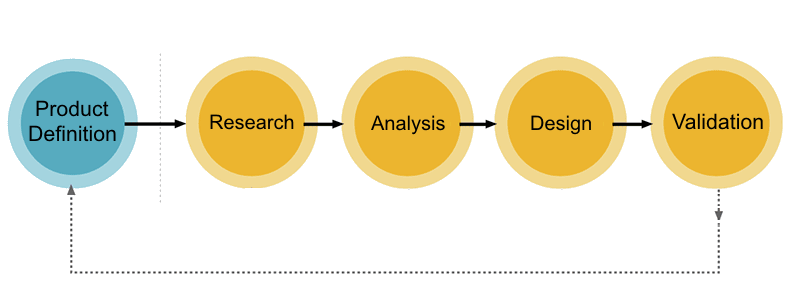

While a lot of people have the idea that User Interface and Experience are the same things, they are in fact two different things. When these two things come together in an effective manner, it creates the phenomenon of an inviting website. A website that is not effectively built can make the users leave in seconds and not even look at what services you offer.
Our team focuses on making the user experience simple and enjoyable while giving them the most information about your business. As we focus on the user’s emotions while creating all our products, their experience is sure to be a pleasant one. With our prototypes and expert advice, you can make sure that your choice is the right one. At the end of your journey with us, your app or website will be effective, beautiful and user friendly.

Our UX design process consists of five key phases:
Our process before we even start working on a project is to establish a relevant context
for its creation. This step decides the basis for the final product. In this process, our
UX/UI team brainstorms the most relevant concepts with you.
This process normally involves:
Stakeholder interviews/ talking to you: We make sure we talk to you, our stakeholder,
about what it is you need and make sure we understand your business goals.
Value proposition mapping: We make sure we think about all aspects of what you and
the product need along with research regarding its need and audience.
Concept creation: This is the creation of an initial prototype of the product.
Once there is a clear definition of the concept, we research the Steps needed to realise the idea.
This also involves competitive user and market research.
Individual in—depth interviews (ID'): The creation of an exceptional product requires a good understanding Of the so having in-depth interviews provides us with data that has a clearer perspective about the target audience, such as their needs, wants, fears, motivations, and behaviour.
Competitive research: Having relevant research helps our UX team understand the current trends and industry standards Which further helps in developing the product within particular niche
The objective of an analysis is to create precision from the data gathered and helping
us in moving on from the “what” to the “why” users need this product.
This normally involves:
Creating user personas: The creation of fictional characters which represent the
different user types for the product helps in having a clearer idea about the target
audience.
Creating user stories: A user story is a tool that helps us understand the product/service
interactions from your perspective.
Storyboarding:This is a tool that helps us connect the user personas and stories with
each other. This helps in giving us the overall picture of what is needed for the product
to reach its appropriate audience and how they interact with the product.
After analysing the user's needs and expectations regarding the product, our designers will create the exact design suited to the product. In this step, the teams will work on steps from creating information architecture (IA) to the actual Ul design.
This step involves:
Sketching: Creating a basic sketch is the fastest way to visualize our ideas. This can be done using a paper, whiteboard or digital tool.
Creating wireframes: A wireframe is a tool that helps designers visualize how the basic structure and elements of a page come together. Wireframing is the foundation of product design and the designers use this step to create functioning prototypes.
Creating a prototype: While wireframes act as a foundation for the structure, the prototype creates the visual for user experience and interaction. It is very similar to a scientific simulation Of the product and may be from low-fidelity (clickable wireframes) to high-fidelity (coded prototypes).
Creating a design specification: The design specifications contain all the visual design resources needed to turn prototypes into a working product.
Creating design systems: Creating a design system for large-scale projects involves having a system for every part of the design - namely components, patterns, and styles - that assists the designers and developers to help each other.
This part of the process involves testing the product and see what the pros and cons of the design are. It is an essential step that helps the team understand the functionality of the design to their users. The testing usually starts after the high fidelity design is processed as this model of work provides greater feedback. During the user testing sessions, our team will aim to get endorsements from both the clients and the users.
The validation process involves these steps:
"In-house Testing": We will test the design and use the product regularly to check its functionality while completing routine operations to uncover any major usability flaws.
Testing sessions: User testing sessions with the target audience is very helpful in understanding various perspectives. We have varied testing methods including moderated/unmoderated usability testing, focus groups, beta testing, and A/B testing.
Surveys: We will conduct surveys Of our users to collect quantitative and qualitative data to see how Our products can be improved. Our design team adds questions about their specific opinions on the product.
Analytics: Having numerical data is a very helpful way to track the efficiency of our product. Our analytics team works on getting your products to the best possible metric before our clients get to see it. This is also a helpful method when it comes to looking into user interaction with the product.